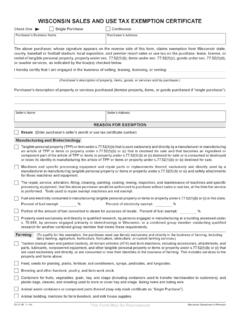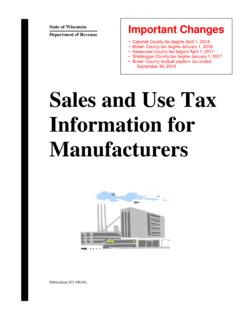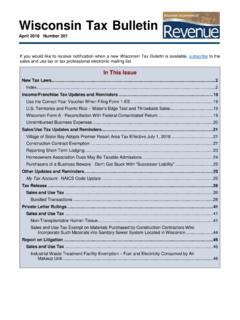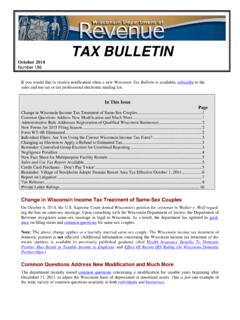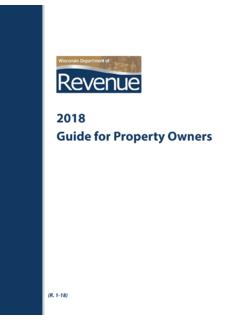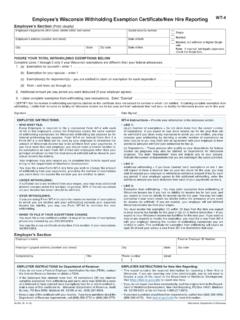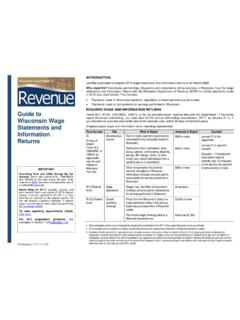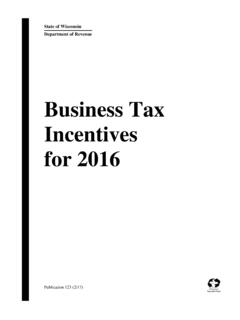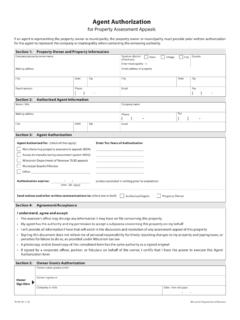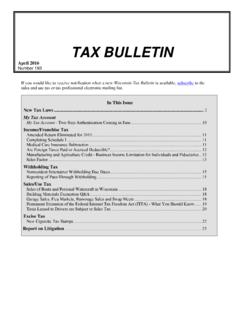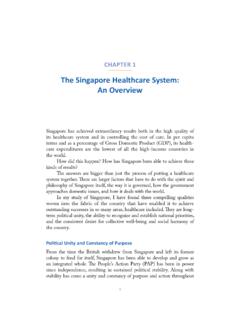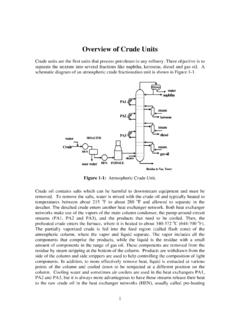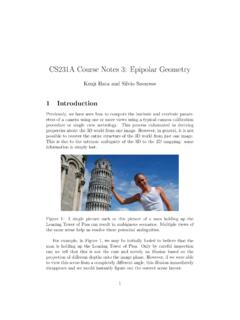Transcription of Property Tax Overview - Wisconsin Department of Revenue
1 Division of Research and Policy December 27, 2019 Property Tax Overview Introduction The Property tax is the primary tax for local governments school districts, technical college districts, counties, municipalities (towns, villages, and cities), and special districts (town sanitary districts, metropolitan sewerage districts, and inland lake districts). Gross Property taxes levied in 2018 for collection in 2019 totaled $ billion, by far the largest tax in the state and local government finance system. For comparison, in fiscal year 2019, state income tax collections were $ billion and state sales tax collections were $ billion. By law, all tangible real Property (land and buildings located on that land) and personal Property ( Property with no land attached to it) are to be taxed unless specifically exempt from taxation. Property owned by the federal government, the state, and by local governments is generally exempt. Property owned and used by churches, universities, educational and charitable facilities, non-profit hospitals, and non-profit housing are also generally exempt.
2 Certain types of personal Property , such as household personal Property , manufacturing machinery and equipment, inventories, computers, and waste treatment equipment, as well as intangible Property , such as bank accounts and corporate securities, are also exempt. The Property tax in Wisconsin is an ad valorem (according to value) tax. While local governments are primarily responsible for administering the Property tax, state statutes determine how these responsibilities are carried out. Classification of Property "General Property " is defined by statute as including all taxable "real" and "personal" Property except that which is taxed under special provisions, such as utility, Forest Crop, and Managed Forest Property . Taxable real Property includes not only the land, buildings, improvements, and fixtures, but also rights and privileges connected with the land. Personal Property includes all goods, wares, merchandise, chattels, and effects having any real or marketable value and not included in real Property .
3 The assessment date for both types of Property is January 1 every year. Wisconsin law requires the assessor to classify land based on use. Real Property is divided into the following statutory classifications: Table 1: Real Property Classes Class Property Category Description 1 Residential Includes any untilled parcel on which a dwelling is located. 2 Commercial Includes parcels where the primary use is the selling of merchandise and/or the provision of a service. Apartment houses with four or more units are included in this class. 3 Manufacturing Includes parcels where the primary use is the assembling, processing, fabricating, making or milling of tangible personal Property for profit. 2 Class Property Category Description 4 Agricultural Includes land where the primary use is for the growing of annual crops, pasturing animals, or similar activities. 5 Undeveloped Includes land such as bog, marsh, lowland brush, uncultivated land zoned as a shoreland, and nonproductive land not otherwise classified.
4 5M Agricultural Forest Includes land capable of producing commercial forest products that meets one of the following requirements: 1) it is contiguous to a parcel that has been classified in whole as agricultural and owned by the same person; or 2) it is located on a parcel where at least 50 percent of the acreage has been converted to agricultural land in the Property assessment of January 1, 2005, or thereafter. 6 Productive Forest Land Includes land that is capable of producing commercial forest products. 7 Other Includes land not included elsewhere, farm buildings and improvements, and the land necessary for these farm-related structures. Classification is important since it affects the assessed value of land classified as agricultural, undeveloped, and agricultural forest (discussed later). Personal Property is divided into the following classes: Table 2: Personal Property Categories Category Description Boats and Watercraft Includes steamboats and other vessels.
5 Machinery, Tools, and Patterns Includes machinery, jigs, and tools that are not otherwise exempt, such as items not used in manufacturing. Furniture, Fixtures, and Equipment Includes furniture and equipment not classified as machinery. Other Includes all other non-exempt personal Property not included in the other categories. Beginning with January 1, 2018 Property tax assessments, machinery, tools, and patterns, not including such items used in manufacturing, will be exempt from personal Property taxes. Value Assessment For Property taxation purposes, there are two critical values that can determine how much a Property owner will pay: 1) assessed value, and 2) equalized value. Assessed values are the values the assessor places on the properties and are used to distribute the municipality's tax burden among the individual Property owners. In Wisconsin , the Department of Revenue (DOR) assesses manufacturing real and personal Property , while the municipal government assessors are responsible for all other Property .
6 All non-agricultural assessments must be based on the market value of Property as of January 1. However, state law recognizes that every municipality cannot be assessed exactly at market value each year. As such, the law allows each municipality to be within 10 percent of market value, provided there is equity between the taxpayers of the municipality. 3 Because assessors in different taxing districts may value Property at different percentages of market value, it is necessary for DOR to convert the assessed values by taxing jurisdiction, to a uniform level. These uniform values are called equalized values. Tax levies for overlying jurisdictions (counties, technical college districts, and school districts) are allocated to each municipality based on that municipality's share of the jurisdiction's total equalized value. As such, any of the following, in addition to other factors, may affect Property tax bills: 1) changes in municipal, school or county Property tax levy; 2) differences in rates of equalized value growth among municipalities or within a municipality; and 3) changes in municipal equalized value share of the school and/or county equalized value.
7 Because of the mechanism discussed above, county, school and technical college districts, for example, would levy a larger share of the Property tax from a municipality with higher equalized value growth rate. The following table shows data for 2018 and 2019 on equalized values by class: Table 3: Equalized Value by Property Class for 2018 and 2019 Property Class Equalized Value Y 2018 Y 2019 Real Property : Residential $388,614,618,400 $412,419,773,600 Commercial $109,739,356,600 $115,437,491,900 Manufacturing $15,085,912,900 $15,899,824,500 Agricultural $2,156,126,600 $2,212,291,500 Undeveloped $2,014,079,800 $2,035,291,600 Agricultural Forest $3,084,110,300 $3,193,795,800 Forest $7,370,166,400 $7,501,047,400 Other $12,090,782,400 $12,383,946,200 Real Property TOTAL: $540,155,153,400 $571,083,462,500 Personal Property : Boats & Watercraft $21,343,800 $24,813,400 Machinery, Tools, and Patterns $1,897,248,400 $2,023,497,800 Furniture, Fixtures, and Equipment $4,857,998,200 $4,974,902,100 Other $2,529,309,700 $2,632,685,100 Prior Year Error Adjustment $71,638,000 $133,362,400 Personal Property TOTAL.
8 $9,305,900,100 $9,655,898,400 Total Equalized Value $549,532,691,500 $580,872,723,300 Undeveloped land and "agricultural forest" land are assessed at 50 percent of full value. The chart below shows percentage shares of all the Property categories: 4 Chart 1: Breakdowns of Equalized Value for 2019 Property Tax Levies The Property tax is generally considered a residual Revenue source for local governments. Every fall, the governing body of each local taxing jurisdiction determines its budget for the following year. The budgeted amount is reduced by other anticipated revenues, with the remaining amount raised from the Property tax. State law may, however, limit the amount that may be raised (as discussed later in this report). The Property tax rate is determined by the levy amount, which is set during the budget process, and the taxing jurisdiction's equalized value. As such, the decline in a municipality's equalized value often leads to an increase in Property tax rate and vice versa.
9 The chart on the next page shows the state-wide equalized value and the average gross Property tax rate over the last 19 years (see Appendix 2 for detail): 5 Chart 2: State's Total Equalized Value (Nominal) and the Average Gross Property Tax Rate (2000-2019) State total Property tax levies for the 2018-19 Property tax year are noted in Table 4, as follows: Table 4: Property Tax Levies by Type of Taxing Unit, 2018-19 Type of Unit # of Units # of Units with Levy Amount Levied School Districts 421 421 $4,987,949,001 Technical College Districts 16 16 $457,204,649 Counties 72 72 $2,229,822,548 Municipalities 1,913 0 $2,922,925,719 Municipalities w/ TIF Districts 452 444 $485,998,607 Special Districts 535 239 $115,039,936 Total 3,410 1,193 $11,198,940,459 $200$250$300$350$400$450$500$550$600 BillionsState-Wide Equalized ValueAverage Gross Property Tax Rate6 The following chart shows percentage shares among the above taxing jurisdictions for the 2018-19 tax year: Chart 3: Levy Percentage Shares by Taxing Unit (2018-19) Property Tax Credits The School Levy Tax Credit is distributed to municipalities based on their share of statewide school levies.
10 The credit reduces individual Property tax bills and is not considered a source of Revenue by school districts and other local governments when setting their annual budgets and determining their Property tax levies. For the 2018-19 Property tax year, the credit totaled to $940 million. During the last 16 years, the amount of school levy tax credit was increased five times from $463 million to $940 million. Chart 4: School Credit and Net Tax Levy (2000 2018) *Figures do not consider the lottery and first dollar credits. School Districts45%Technical College Districts4%Counties20%Municipalities26%M unicipalities w/ TIF Districts4%Special Districts1% $0$2,000$4,000$6,000$8,000$10,000$12,000 MillionsSchool CreditNet Tax Levy*Net Tax Rate*Schoolcredit was increased from $ million to: $ (2006), $ million (2007), $ million (2008), $ million (2015) and $ million (2017).7 The credit is calculated based on the prior 3 years' school tax levies (school district levies and levies for county-operated schools for children with disabilities) levied in each municipality.
